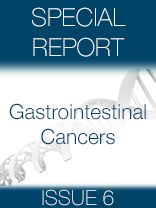Carboplatin/Paclitaxel Neoadjuvant Regimen Worthy of Phase II Investigation in Esophageal Cancer
Carboplatin/paclitaxel-based chemoradiotherapy (CarPacRT) has sufficient activity to progress into phase II clinical trials as neoadjuvant treatment for patients with resectable esophageal cancer.
Carboplatin/Paclitaxel Neoadjuvant Regimen in Esophageal Cancer

Somnath Mukherjee, MD
Carboplatin/paclitaxel-based chemoradiotherapy (CarPacRT) has sufficient activity to progress into phase II clinical trials as neoadjuvant treatment for patients with resectable esophageal cancer.
Data from the randomized phase II NEOSCOPE trial demonstrated good tolerability for the CarPacRT regimen while producing a pathologic complete response (pCR) rate of 27.9%, according to Somnath Mukherjee, MD, at the 2016 Gastrointestinal Cancers Symposium.
Neoadjuvant oxaliplatin/capecitabine chemoradiotherapy (OxCapRT) failed to demonstrate activity to move forward, he said.
“Neoadjuvant chemoradiotherapy is a standard of care for operable esophageal cancer,” said Mukherjee, Department of Oncology, CRUK/MRC Institute for Radiation Oncology, University of Oxford, but he maintained that evidence suggests the current chemoradiotherapy standard practice may be improved upon by using a different chemoradiotherapy combination.
Both weekly carboplatin/paclitaxel-based neoadjuvant chemoradiotherapy and oxaliplatin/fluoropyrimidine-based neoadjuvant chemoradiotherapy have shown promise in multiple clinical trials. In a definitive trial of oxaliplatin/5-flurouracil (5-FU) versus cisplatin/5-FU-based chemoradiotherapy, oxaliplatin/5F-U had shown comparable efficacy but less toxicity.
In NEOSCOPE, patients with operable cancer of the mid-lower esophagus/gastroesophageal junction received induction chemotherapy with two cycles of oxaliplatin and capecitabine. Eligible patients were those with tumor stage ≥T3 and/or ≥N1 and a total disease length <8 cm. They were randomized 1:1 to OxCapRT (oxaliplatin, 85 mg/m2on alternate weeks; capecitabine, 625 mg/m2on the days of radiotherapy) or CarPacRT (carboplatin area under the curve 2 weekly; paclitaxel 50 mg/m2weekly). All patients underwent imaging to restage their disease, with surgery scheduled for 6 to 8 weeks following radiation therapy. The recommended surgery was a two-phase esophagectomy with two-field lymphadenectomy; minimally invasive esophagectomy was allowed.
The rate of pCR was the primary endpoint, with a “pick a winner” design to the trial. “A pCR of 15% was not considered large enough to warrant further investigation, whilst a pCR of 35% was considered worthwhile,” said Mukherjee. Either arm having at least 10 pCRs out of the first 38 patients would be considered for phase III.
Eighty-five patients were randomized. Tumor characteristics were balanced between the two arms. Approximately 86% of patients, overall, had stage T3 disease and 57 of the 85 were node positive. The predominant tumor site was the lower third of the gastroesophageal junction (76.2% in the OxCapRT arm; 90.7% in the CarPacRT arm); 14.3% in the OxCapRT arm had the middle third as the site of the predominant tumor compared with 4.7% in the CarPacRT arm. The maximal disease length was 5.85 cm and 5.7 cm in the two arms, respectively.
Thirty six of 42 randomized to OxCapRT proceeded to surgery compared with 41 of 43 randomized to CarPacRT. The principle reasons for not proceeding to surgery included disease progression and death during chemotherapy.
“Overall, the toxicity was similar across the arms, although the incidence of neutropenia was higher in the CarPacRT arm, 21.4% versus 2.6%,” said Mukherjee.
There were three deaths on the study; all occurred during induction chemotherapy.
Treatment was very well tolerated and treatment compliance was high. Median dose intensity was 96.9% for oxaliplatin, 97.5% for capecitabine, 85.3% for carboplatin, and 82.5% for paclitaxel. Similarly, radiotherapy was extremely well tolerated: 38 of 38 patients in the OxCapRT arm and 41 of 42 in the CarPacRT arm received full-dose radiotherapy.
About half of three patients in each arm experienced postoperative complications by 30 days on the treatment. Cardiac complications were slightly higher in the OxCapRT arm compared with the CarPacRT arm (25.0% vs. 9.8%), but the difference was not statistically significant.
The R1 resection rate, defined as tumor within 1 mm of the circumferential resection margin, was 27.8% in the OxCapRT arm and 19.5% in the CarPacRT arm.
The pCR rates were 11.9% in the OxCapRT arm and 27.9% in the CarPacRT arm by intent to treat. “Ten of the first 38 patients in the CarPacRT arm attained pCR, thereby meeting the prespecified criteria for success,” said Mukherjee.
Putting the NEOSCOPE data into context is challenging when considering the wide range of pCR rates, from 13% to 50%, in clinical trials of neoadjuvant chemoradiotherapy, with or without induction chemotherapy, according to invited discussant Daniel V.T. Catenacci, MD, assistant professor of medicine, University of Chicago.
Further, there was overlap in the 95% confidence intervals in the two arms of NEOSCOPE given its small size, he said, and “imbalances in poor prognostic factors disfavoring the oxaliplatin arm.” Patients in the CarPacRT arm had a 10% lower rate of advanced disease and a lower rate of proximal disease as well, for which R0 resection is more difficult.
The CALGB 80803 trial, in which positron imaging/computed tomography is being used to determine whether or not a particular chemotherapy regimen is having an effect on tumor size in patients with esophageal cancer, may provide more clarity, according to Catenacci.
References
- Mukherjee S, Hurt C, Gwynne S, et al. NEOSCOPE: A randomised phase II study of induction chemotherapy followed by either oxaliplatin/capecitabine (OXCAP) or carboplatin/paclitaxel (CarPac) based chemoradiation (CRT) as pre-operative regimen for resectable oesophageal adenocarcinoma. J Clin Oncol. 2016;34 (suppl 4S; abstr 3).

The Impact of the Gut Microbiome in Young Patients With Colorectal Cancer
February 15th 2021In season 2, episode 2 of Targeted Talks, Cathy Eng, MD, speaks with Benjamin Weinberg, MD, about the gut microbiome, and how the presence of certain microbiota impact the onset and intensity of disease as well as the potential response to certain treatments.
Listen
Durvalumab Plus Chemo Continues to Improve Survival in Biliary Tract Cancer
April 16th 2024Results from a 3-year follow-up of the TOPAZ-1 trial showed that treatment with durvalumab plus chemotherapy in advanced biliary tract cancer continued to improve overall survival vs chemotherapy alone.
Read More
Biomarker Testing Paves the Way for Better Targeted Therapies in NSCLC
April 16th 2024At a live virtual event, Edward S. Kim, MD, MBA, discussed the evolving landscape of biomarker testing before making treatment decisions for patients with early-stage non–small cell lung cancer (NSCLC).
Read More